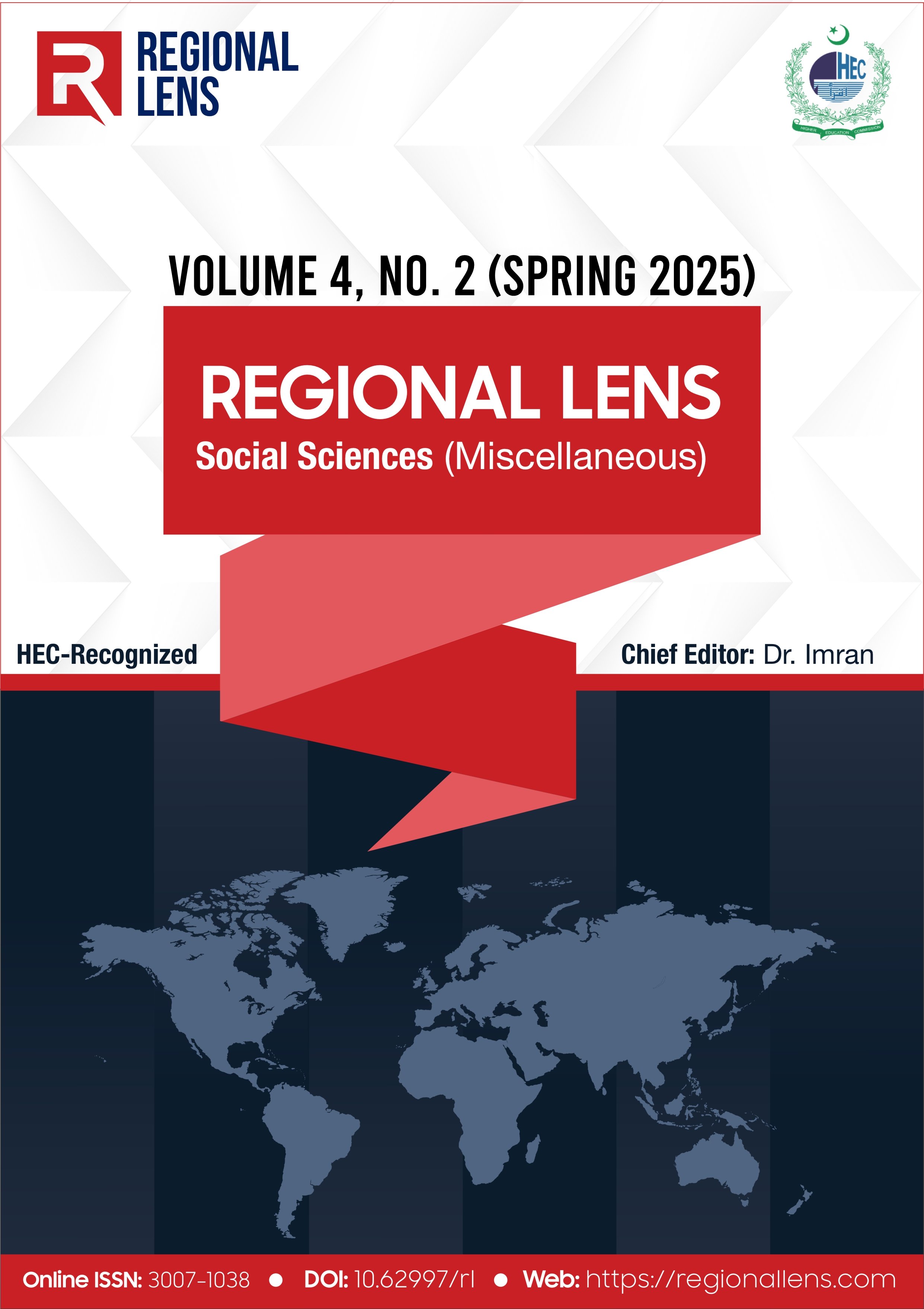Masculine Hegemony through Humor in Pakistan: A Linguistic Study
DOI:
https://doi.org/10.55737/rl.2025.42072Keywords:
Masculine, Hegemony, Gender Stereotyping, Sexist Internet Jokes, Pakistani WomenAbstract
The aim of this paper is to examine Pakistani jokes shared on social media that promote masculine hegemony through humor, specifically focusing on sexist jokes made at the expense of Pakistani women. The study aims to investigate how these jokes promote gender inequity and strengthen male dominance in Pakistan's patriarchal society. By subtly conveying prejudice and unfavorable opinions, jokes can influence readers' unconscious prejudices (Allport, 1954; Freud, 2004). The paper investigates how language is used to support sexist sentiments and is divided into four sections that examine how women are portrayed in language, in public and private settings, and as sexual objects. The study employs Foucault’s social aspect of discourse (1970) and Van Dijk's (2003) critical discourse analysis.
References
Ahmed, S. (2013). The cultural politics of emotion. Edinburgh University Press.
Al-Rawi, A., Grepin, K., Li, X., Morgan, R., Wenham, C., & Smith, J. (2021). Investigating public discourses around gender and COVID-19: A social media analysis of Twitter data. Journal of Healthcare Informatics Research, 5(3), 249–269. https://doi.org/10.1007/s41666-021-00102-x
Al-Zubaidi, N. A. (2019). Woman stereotypes and patriarchal hegemony: A feminist stylistics analysis of Iraqi folk proverbs. Alustath Journal for Human and Social Sciences, 58(1), 67–84. https://doi.org/10.36473/ujhss.v58i1.836
Ali, T. S., Krantz, G., Gul, R., Asad, N., Johansson, E., & Mogren, I. (2011). Gender roles and their influence on life prospects for women in urban Karachi, Pak0istan: a qualitative study. Global health action, 4(1), 7448. https://doi.org/10.3402/gha.v4i0.7448
Allport, G. W., Clark, K., & Pettigrew, T. F. (1954). The nature of prejudice (Vol. 2, pp. 59-82). Reading, MA: Addison-wesley.
Andrade, C. (2021). The inconvenient truth about convenience and purposive samples. Indian Journal of Psychological Medicine, 43(1), 86–88. https://doi.org/10.1177/0253717620977000
Anthony, A., Jabeen, D. F., & Abbas, D. S. (2023). Investigating gender-based humor in Punjabi stage dramas in the digital age. Journal of Journalism, Media Science & Creative Arts, 3(2), 32–52. https://doi.org/10.56596/jjmsca.v3i2.73
Bem, S. L. (1993). The lenses of gender: Transforming the debate on sexual inequality. Yale University Press.
Bitterly, T. B. (2022). Humor and power. Current Opinion in Psychology, 43, 125–128. https://doi.org/10.1016/j.copsyc.2021.06.017
Butler, J., & Trouble, G. (1990). Feminism and the Subversion of Identity. Gender trouble, 3(1), 3-17.
Cameron, D. (1985). Feminism and linguistic theory. New York: St. Martin’s Press.
Cameron, D. (2008). The myth of Mars and Venus: Do men and women really speak different languages? Oxford University Press.
Ciaffoni, S., Rubini, M., & Moscatelli, S. (2025). The unbearable weight of gender inequalities: Development and validation of the Social Treatment and experiences of women (STEW) scale. Sex Roles, 91(1). https://doi.org/10.1007/s11199-024-01555-1
Crawford, M. (2003). Gender and humor in social context. Journal of Pragmatics, 35(9), 1413–1430. https://doi.org/10.1016/s0378-2166(02)00183-2
Dean, R. A. K., & Gregory, D. M. (2004). Humor and laughter in palliative care: An ethnographic investigation. Palliative & Supportive Care, 2(02), 139–148. https://doi.org/10.1017/s1478951504040192
Delgado, R., & Tibau, X.-A. (2019). Why Cohen’s Kappa should be avoided as performance measure in classification. PloS One, 14(9), e0222916. https://doi.org/10.1371/journal.pone.0222916
England, D. E., Descartes, L., & Collier-Meek, M. A. (2011). Gender role portrayal and the Disney princesses. Sex Roles, 64(7–8), 555–567. https://doi.org/10.1007/s11199-011-9930-7
Fakhar, M. S., Munir, M. I., Zia, M. F., & Rasheed, M. S. (2024). Transformative power of education: unraveling gender roles in Pakistan through a comprehensive literature review. Jahan-e-Tahqeeq, 7(1), 667–675. https://jahan-e-tahqeeq.com/index.php/jahan-e-tahqeeq/article/view/1199
Finn, P., & Laaboudi, D. (2024). Submissive housewives, unfaithful spouses, dysfunctional marriages and violence: the portrayal of gender roles and marriage in Moroccan jokes. The Journal of North African Studies, 1–21. https://doi.org/10.1080/13629387.2024.2349049
Flouli, A., & Athanasiades, C. (2023). The discourse of resistance against spoken sexism. Psychology: The Journal of the Hellenic Psychological Society, 28(1), 48-62. https://psycnet.apa.org/doi/10.12681/psy_hps.34687
Ford, T. E. (2000). Effects of sexist humor on tolerance of sexist events. Personality & Social Psychology Bulletin, 26(9), 1094–1107. https://doi.org/10.1177/01461672002611006
Ford, T. E., Boxer, C. F., Armstrong, J., & Edel, J. R. (2008). More than “just a joke”: The prejudice-releasing function of sexist humor. Personality and social psychology bulletin, 34(2), 159-170. https://doi.org/10.1177/0146167207310022
Ford, T., Boxer, C., Armstrong, J., & Edel, J. (2013). Sexist humor and beliefs that justify societal sexism. Current Research Social Psychology, 64–81.
Foucault, M. (1970). The archaeology of knowledge. Social Sciences Information. Information Sur Les Sciences Sociales, 9(1), 175–185. https://doi.org/10.1177/053901847000900108
Foucault, M. (1978). The history of sexuality volume I. In Feminist Studies (pp. 61-66). Routledge.
Freud, S . (2004). Der witz und seine beziehungzumunbewußten/derhumor. Frankfurt (Main), Hessen, Germany: Fischer TaschenbuchVerlag.
Graddol, D. (1989). Gender voices. Blackwell Publishing.
Haider, A. S., & Al-Abbas, L. S. (2022). Stereotyping Arab women in jokes circulated on social media during the coronavirus crisis. European Journal of Humour Research, 10(1), 168–185. https://doi.org/10.7592/ejhr2022.10.1.569
Hall, S. (1997). The spectacle of the other. Representation: Cultural representations and signifying practices, 7, 223-290.
Hall, S. (2001). The Spectacle of the Other. I: Discourse theory and practice. A reader. Eds.: Margaret Wetherell, Stephanie Taylor & Simeon J. Yates. London–Thousand Oaks–New Delhi. S, 324-344.
Horisk, C. (2024). Dangerous jokes: How racism and sexism weaponize humor. Oxford University Press.
Ida, R., & Tuty, H. (2023). Women, gossip, and film: social and cultural construction on women's behavioral engagement in gossiping. International Journal of Media and Information Literacy, 8(1), 191-203. https://doi.org/10.13187/ijmil.2023.1.191
Kargupta, S., Biswas, S. D., & Das, P. K. (2023). The therapeutic power of laughter: Exploring the role of humor in communication and well-being. International Journal of English Learning & Teaching Skills, 6(1), 3558–3565. https://doi.org/10.15864/ijelts.6104
Khan, A. (2018). A study of social information seeking (SIS) among LIS research scholars in Pakistan. Publications, 6(1), 3. https://doi.org/10.3390/publications6010003
Lakoff, R. (1975). Language and woman's place. Harper & Row.
Leskinen, E. A., Rabelo, V. C., & Cortina, L. M. (2015). Gender stereotyping and harassment: A “catch-22” for women in the workplace. Psychology, Public Policy, and Law: An Official Law Review of the University of Arizona College of Law and the University of Miami School of Law, 21(2), 192–204. https://doi.org/10.1037/law0000040
Lutz, C. (1990). Engendered emotion: Gender, power, and the rhetoric of emotional control in American discourse. University of Michigan Press.
Macdonald, M. (1995). Representing women: Myths of femininity in the popular media. London: Edward.
Martineau, W. H. (1972). A model of the social functions of humor. The psychology of humor, 101-125. https://doi.org/10.1016/B978-0-12-288950-9.50011-0
Mills, S. (2008). Language and sexism. Cambridge: Cambridge University Press.
Nayef, H., & El-Nashar, M. (2014). Promoting masculine hegemony through humour: A linguistic analysis of gender stereotyping in Egyptian sexist internet jokes. International Journal of Linguistics and Communication, 2(4). https://doi.org/10.15640/ijlc.v2n4a5
Oduor, V. O. (2022). Through the lens of gender: Sex jokes in selected contemporary East African popular fiction. In Sexual Humour in Africa (pp. 123-138). Routledge.
Rashad, S., & Azher, M. (2018). “women in jokes”: A linguistic analysis of jokes on Pakistani social media in light of the General Theory of Verbal Humour. Pakistan Journal of Women’s Studies, 25(2), 113–132. https://doi.org/10.46521/pjws.025.02.0049
Rozek, C. (2015). The gender divide in humor: How people rate the competence, influence, and funniness of men and women by the jokes they tell and how they tell them (Doctoral dissertation, Wellesley College).
Salam, R. (2020). Compliance and resistance: An investigation into the construction of gender identities by Pakistani women on Facebook. Asian Journal of Women’s Studies, 26(4), 503–527. https://doi.org/10.1080/12259276.2020.1854414
Sanauddin, N. (2015). Proverbs and patriarchy: analysis of linguistic sexism and gender relations among the Pashtuns of Pakistan (Doctoral dissertation, University of Glasgow).
Shah, A., Khattak, N. U. R., & Kanwal, A. (2022). The Role Of Jokes In Social Stereotyping: Analysis Of Web-Based Jokes In Pakistan. Webology, 19(2).
Sultana, Y., Saeed, N., & Rehman, T. U. (2020). Gender Representation in SMS Jokes. In Advances in Media, Entertainment, and the Arts (pp. 140–155). IGI Global.
Sunderland, J. (2007). Contradictions in Gendered Discourses. Gender and Language, 1(2), 207-228. https://doi.org/10.1558/genl.v1i2.207
Sunderland, J. (Ed.). (2006). Language and gender: An advanced resource book. London: Routledge.
Tajfel, H., & Turner, J. C. (2004). The social identity theory of intergroup behavior. In Political psychology (pp. 276-293). Psychology Press.
Talbot, M . (1998). Language and gender: An introduction. Cambridge: Polity.
Van Dijk, T. (2003). The Discourse-Knowledge Interface. In G. Weiss, & R. Wodak (Eds.), Critical Discourse Analysis (pp. 85-109). Hampshire: Palgrave MacMillan.
Weber, S., Appel, M., Steffens, M. C., & Hirschhäuser, V. (2023). Just a joke? Can sexist comedy harm women’s cognitive performance?. Psychology of Aesthetics, Creativity, and the Arts, 17(5), 608. http://dx.doi.org/10.1037/aca0000369
Woodzicka, J . A., Ford, T . E. (2010). A framework for thinking about the (not so funny) effects of sexist humor. Europe's Journal of Psychology, 3, 174-195. http://dx.doi.org/10.5964/ejop.v6i3.217




